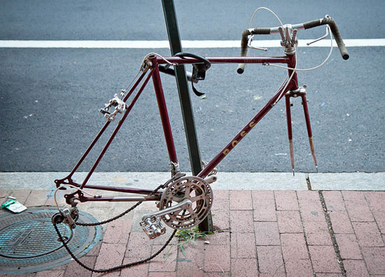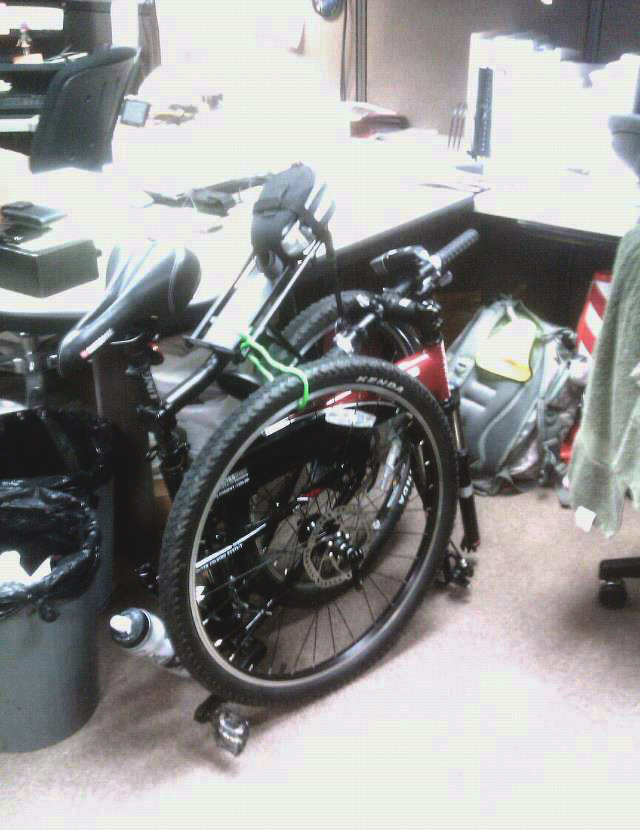Not many, if any of us – are lucky enough to receive a written apology from the thief if someone steals our bike. This along with getting the bike back happened for one very fortunate man in Oregon. For most of us, if our bike is stolen it is sadly a one way street. Local media are reporting increases in bicycle theft in the greater Boston area (which is where we are based). So what can we do?

I love my bike! I want to keep it safe!
Earlier this year The New York Times reported on bike theft with a special mini-documentary. The author of the article, Casey Neistat writes,
“In the nearly 11 years since that [first] day [in New York], I have had countless bikes and parts stolen. I’ve used the most secure locks, registered my bike with the N.Y.P.D., and parked in only the most conspicuous locations. But I’ve found only one sure way of keeping my bike secure: keeping it indoors. During business hours I keep my bike in my office and when I get home I carry it up four flights of stairs.”
Four flights may seem daunting, especially if you don’t ride every day or are new to bike commuting. This entire thing may seem like a reason not to ride a bike at all. Whether you’re a long term devotee of cycling – riding no matter the weather or circumstances; or a newcomer or occasional cyclist – it doesn’t have to be this arduous, even when choosing the most secure option of keeping your bike indoors.
Enter the folding bike. Fold it up, take it inside. This is a much simpler option than navigating the narrow switchbacks of a four story walk-up carrying a bicycle. (Or at point case in my life, a seven story.) And even if your living situation is much more spacious, the added security is well worth it.
Being Well Informed to Confront Bike Theft
Watching The New York Times video teaches us one simple thing, that a determined thief can get your bike given time and tools. But there is no need to be fatalistic, there are things you can do. There are better locking techniques and better locks, and further action you can take to be well informed.
There have been several notable articles over the past year on bike theft, the why, where and strife of it all. The cities most infamous for bike theft are New York and San Francisco. (These are worth the read.)
A Few Tips
The lock itself: a U-lock – may seem like overkill but it takes longer to forcibly remove, and may just mean that your bike is passed over in favor of one with a cable. (We’ve talked about this a bit before.) This is the way to go. In fact the thief who wrote the apology to the Oregonian man mentioned earlier recommended a U lock to him.
Cable lock: just won’t do. (For a comedic take on this, check out Bikeyface.)
Register: Register Your Bike with the National Bike Registry. Turn your bike upside down. Pedals connect to cranks, cranks connect to the spindle at the bottom bracket. Most bicycles have their serial number stamped on the bottom of the bracket shell. This is how stolen bikes can be identified if recovered. Most bike parts and componentry do not have a serial numbers, so it pays to register the frame. Register your bike with the manufacturer if you get it new. (Here for Montague Bikes.) Some municipalities and police departments have bike registrations too. (In Boston the Boston Cyclists Union has one.)
Other ideas:
From Boston Magazine:
“Pete Stidman, of the Boston Cyclists Union, offers a few more suggestions for avoiding bike theft:
- Make your bike ugly: Shiny new bikes attract thieves because they know they’ll likely get a higher resale price. Stidman suggests using tape or other materials to cover over some of the labels on your bike and to give it a more well-loved look.
- Fix your quick release wheels: Many racing or mountain bikes have wheels that are easily detached. Installing locking hubs on your wheels will ensure that a thief can’t walk away with your parts.
- Watch where you lock up (bike edition): If you only put a lock under your handlebars or just below the seat, a thief can easily detach the seat or handlebars and take off the the rest of the frame.
- Watch where you lock up (post edition): Many bike racks are in low-trafficked areas where few people wander by. Make sure to lock your bike up in a highly visible place, and be sure that the location you’re locking your bike to is secure and can’t be moved or pulled up from the ground.
- U-locks: They’re stronger and harder to break than chains or cable locks. When in doubt, use more than one. “


